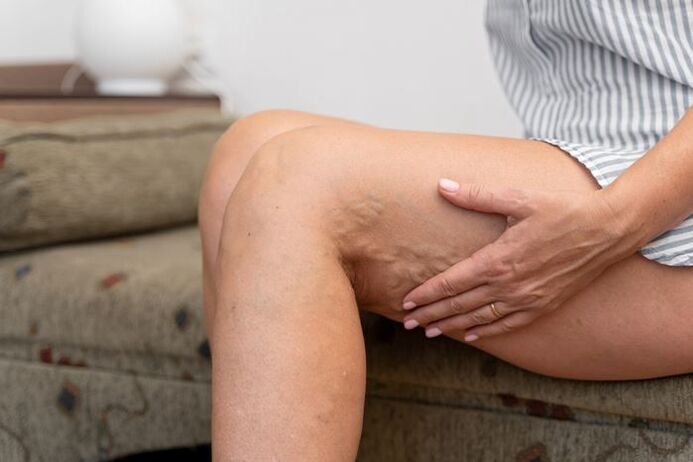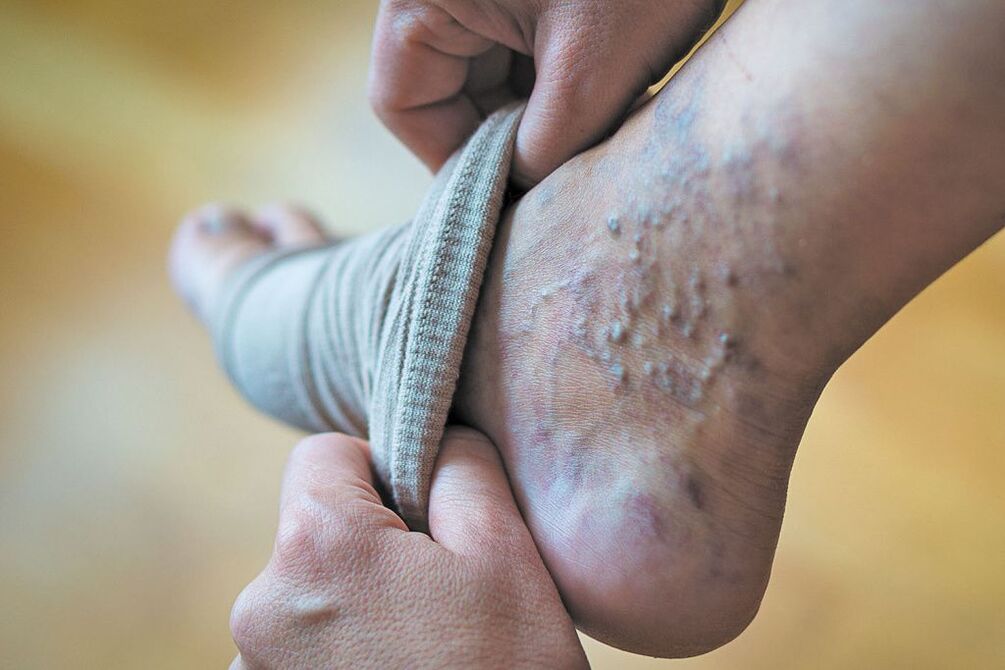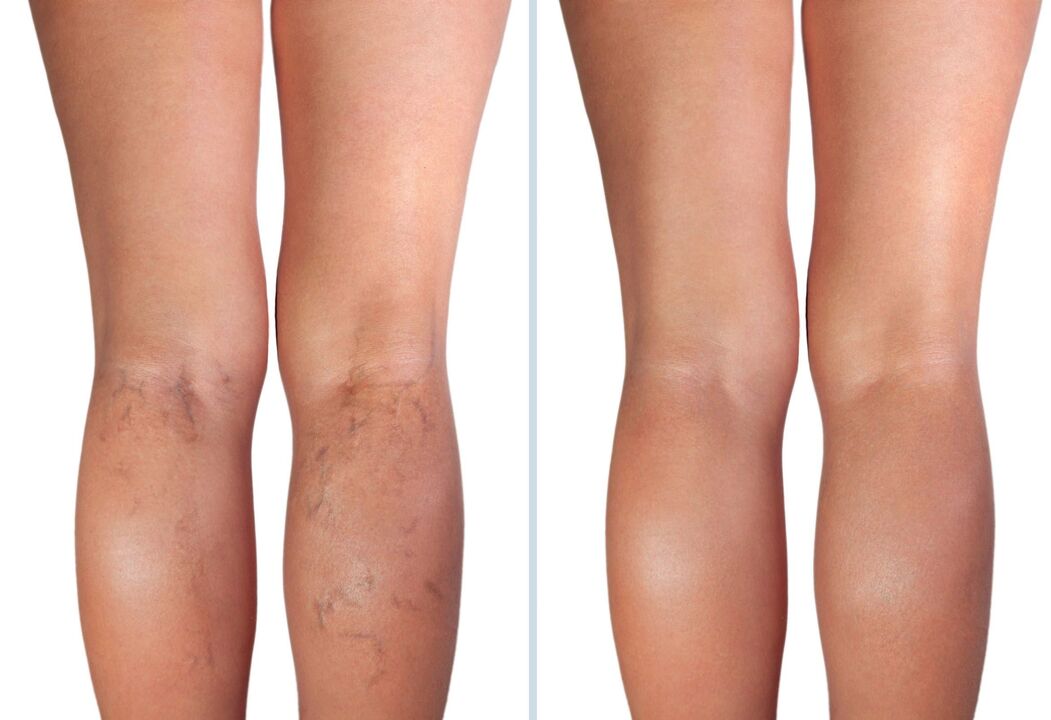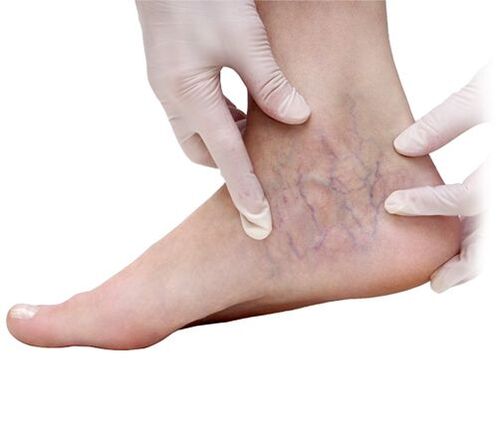
Varicose veins, varicose veins, varicose veins(from Latin varix, varicis – expansion, swelling of the veins)- persistent irreversible change in the veins, characterized by:
- uneven increase in the lumen and length of the veins,
- the formation of nodes in areas of thinning veins due to pathological changes in the venous walls, their thinning, stretching, reduced tone and elasticity,
- functional insufficiency of venous valves and impaired blood flow.
Varicose veins are a fairly common disease. Varicose veins and their complications are diagnosed in 25% of the population, with women being affected two to three times more often than men. In women, the first signs of the disease are often observed at a young age, usually in connection with pregnancy and childbirth. With increasing age, the incidence increases in both men and women and the frequency of complicated forms increases. At the age of 70, the disease occurs 6-10 times more often than at the age of 30. However, recently the manifestation of varicose veins is often observed in very young people, even teenagers. It is therefore becoming increasingly urgent to identify all possible causes of illness and to prevent venous diseases.
How varicose veins arise and develop
To understand how varicose veins develop, we will briefly explain the physiology of the venous system of the lower extremities. Venous outflow in the legs is ensured by two interconnected mechanisms - central and peripheral. The central mechanism is associated with the heart, lungs and diaphragm, and the peripheral mechanism is directly related to the function of the venous system of the lower extremities, which surrounds the muscle and tissue vessels.
The first signs of varicose veins are impaired capillary blood flow, swelling, a feeling of heaviness in the legs, the appearance of spider veins and spider veins. These changes are reversible, but if preventative measures are not taken in time, the problems will increase.
It usually takes more than a year from the first signs of varicose veins of the lower extremities to the formation of varicose veins and the appearance of pronounced varicose vein symptoms. Varicose veins develop gradually and lead to circulatory problems and chronic venous insufficiency. Blood congestion in the veins can lead to phlebitis (inflammation of the veins), thrombophlebitis (inflammation of the veins with the formation of blood clots), phlebothrombosis (thrombosis with further inflammation of the veins), non-healing dermatitis (inflammation of the skin), trophic ulcers.
Types and forms of varicose veins

There are primary (true) and secondary (symptomatic) varicose veins.
Primary varicose veins are an independent disease of the venous system (varicose veins). It develops gradually over several years. Most often, varicose vein enlargement of the great saphenous vein is observed (70–85%), less often – the small saphenous vein (5–12%). In varicose veins, 50-70% of vein damage is bilateral.
Secondary varicose veins are a symptom and consequence of diseases in which the outflow of blood through the deep veins of the lower extremities is obstructed (post-thrombotic diseases, tumors, scars, inflammatory processes, aplasia and dysplasia of deep veins, arteriovenous). fistulas etc. ). Secondary varicose veins are quite rare.
Varicose veins most commonly affect the saphenous veins of the lower extremities, which are part of the large saphenous vein system. The branches of the small saphenous vein suffer from varicose veins much less often.
Classification of types of varicose veins
Until recently, doctors in our country classified varicose veins according to different classification types. V. S. Savelyev's graded clinical classification was used, which reflects the degree of disruption of venous circulation in the limb and the ability of the body to resist and compensate for these disorders, as well as a classification according to the forms of varicose veins and those caused by themcaused complications.
However, the most important at present is the international classification CEAP, which is based on clinical (C - clinical), etiological (E - etiology), anatomical (A - anatomy) and pathogenetic (P - pathogenesis) features of the disease.
6 clinical classes ("C") are ordered by increasing disease severity, from telangiectasia (TAE) to trophic ulcers.
The etiological section ("E") indicates whether the process is primary or not.
The anatomical part of the classification ("A") divides the venous system of the lower extremities into 18 relatively separate segments, which makes it possible to indicate the localization of the affected area of the venous system.
The pathophysiological section ("P") characterizes the presence of reflux and/or obstruction in the affected venous segment.
Symptoms of varicose veins

The symptoms of varicose veins depend on the stage of the disease, i. e. H. about the extent of changes in the blood vessels and disorders of the venous system. Depending on the stage, a prognosis can be given for the further course of the disease.
The initial stage of varicose veins - 1st degree varicose veins
At the initial stage, when the pathology of the veins is not yet clearly expressed, visible signs of varicose veins may be absent. Patients complain of heaviness and discomfort in the legs, tiring too quickly, feeling warm, and paresthesia (numbness, burning, tingling). Symptoms worsen towards the end of the day and when exposed to heat - in summer or when wearing warm shoes in winter. Swelling occurs in the foot and ankle, which disappears after a short break. Occasionally, nighttime cramps in the calf muscles are possible, but patients attribute these to overuse.
After prolonged physical activity, the veins swell and their network is clearly visible through the skin. They are particularly noticeable in the thigh, lower leg and foot areas. The number of such wires and the degree of their extension can vary. These can be individual and less noticeable formations on the lower leg that become more noticeable in the evening or after physical activity. The appearance of spider veins is also observed at this stage of varicose veins.
If you start the simplest conservative treatment at this stage and take preventive measures, the development of the disease can be prevented by eliminating almost all symptoms.
Symptoms of grade 2 varicose veins, compensation stage
At this stage of the disease, changes in large subcutaneous vessels become noticeable. The veins become deformed, swell, blood flow is disrupted and there is significant swelling in the feet and ankles. Swelling in the legs increases with prolonged physical activity but disappears after a night's rest. Cramps in the calf muscles often occur at night. Paresthesia is observed - a temporary loss of sensitivity in the legs, numbness in the legs, burning, "goosebumps". As the disease progresses, pain appears, which increases in the evening.
This stage of subcompensation usually lasts several years, and at this time the development of the disease can also be stopped if treatment is started in a timely manner. Otherwise, the disease will inevitably progress to a more severe stage.
Symptoms of grade 3 varicose veins - decompensation stage
In this stage of varicose veins there is a significant increase in symptoms, pain and heaviness in the legs become more intense and there is a disruption in peripheral blood and lymph circulation (chronic venous insufficiency). The swelling does not go away even after a long period of rest and spreads to the lower leg. Patients suffer from itchy skin. The skin on the legs becomes dry, loses elasticity, the skin is easily injured, loses the ability to regenerate quickly, as a result of which wound healing takes a long time. Brown spots appear on the skin, most commonly on the inside of the lower third of the leg (hyperpigmentation due to subcutaneous bleeding).
All of these complaints occur all the time. In the future, complaints of pain in the heart area, shortness of breath, headaches and deterioration of the musculoskeletal function of the affected limb may appear.
Although the stage of decompensation is already a very significant manifestation of the disease, with appropriate treatment, the patient's condition can be maintained at a satisfactory level for a long period of time, thereby maintaining the ability to work and preventing the transition to the phase of complications.
Grade 4 varicose veins – stage of complications
This phase of the disease is characterized by pronounced disorders of venous blood circulation. The swelling of the legs becomes almost constant, the itching of the skin increases, and trophic disorders appear on the skin of the lower leg. Advanced varicose veins are often accompanied by eczema, dermatitis and long-term injuries and since the skin's ability to regenerate with varicose veins is significantly limited, even a small wound can develop into a stubborn trophic ulcer. Thin skin and vein walls can be easily injured, resulting in excessive bleeding. Damaged soft tissues and open ulcers become entry points for infections.
The most common complications of varicose veins:
- Phlebitis – Inflammation of a vein;
- Thrombosis – the formation of a blood clot (thrombus) in a vein, which can lead to blockage of the vessel;
- trophic ulcers - arise in the place where the affected vein cannot ensure sufficient outflow of blood from the skin, as a result of which the nutrition (trophism) of the tissue is disrupted.
Varicose veins can be complicated by acute (sometimes purulent) thrombophlebitis,Dermatitis and eczema, bleeding, erysipelas, lymphangitis.One of the most dangerous complications of varicose veins is pulmonary embolism, which can lead to sudden death.
Restoring the condition of the venous system is no longer possible at this stage; all that remains is to prevent further complications and, if possible, improve the patient's quality of life.
Causes of varicose veins
There is no consistent cause of primary varicose veins of the lower extremities. The development of this disease is usually provoked by several factors. However, all painful symptoms of varicose veins are associated with structural changes in the tissue of the venous walls of blood vessels and dysfunction of the venous valves.
What causes these violations?
One often comes across the statement that one of the most important physiological reasons for the development of a disease such as varicose veins is the upright posture. In fact, the strain on the vascular system of the lower extremities in humans is naturally very high. The flow of blood from the veins and its ascent to the heart is prevented by the pressure caused by gravity, as well as high pressure in the abdominal cavity. However, not everyone develops varicose veins. What factors provoke the development of varicose veins?
It has been found that the main risk factors for the development of varicose veins are:
- genetic predisposition (heredity) – congenital weakness of the venous wall, disorder of the venous valves;
- female gender – women suffer from varicose veins 4-6 times more often than men;
- hormonal disorders;
- hormonal contraception;
- Pregnancy, especially multiple pregnancies;
- heavy physical activity (heavy physical work, weight training);
- Conditions and diseases leading to increased intra-abdominal pressure (chronic respiratory diseases, constipation, etc. )
- Diseases that negatively affect blood vessels (high blood sugar, diabetes, pressure surges, etc. );
- Characteristics of work – standing or sitting work, sudden temperature changes, prolonged contact with high or low temperatures;
- Overweight, obesity, which leads to increased load on the legs and increased pressure in the pelvic area;
- Lack of vitamin C and other useful substances necessary for the vascular system;
- a sedentary lifestyle, bad habits that destroy blood vessels and create additional tension in them.
Diagnosis of varicose veins

In most cases, diagnosing varicose veins is not difficult. A clinical examination, including physical examination (examination and palpation), questioning the patient, collecting complaints and anamnesis (information about the course of the disease, life and work characteristics, previous and current diseases) for severe varicose veins is usually carried out. It is possibleTo make a diagnosis without instrumental examination. Exceptions are situations in which, with excessive development of subcutaneous fatty tissue of the lower extremities, spasmodic changes may be difficult to detect.
Currently, duplex ultrasound examination (USDS) is widely used to examine the veins of the lower extremities. This method allows you to determine the localization of changes in the veins and the nature of the disorder in venous blood flow. However, you need to know that the results of ultrasound examination are largely subjective and depend not only on the experience and knowledge of the researcher, but also on the tactical approaches to the treatment of venous diseases in a particular medical institution. When determining treatment tactics, they are primarily guided by clinical examination data.
When planning invasive treatment of varicose veins of the lower extremities, a duplex scan is performed. In addition, X-ray contrast venography, MRI venography and CT venography can be used.
All of these methods make it possible to clarify the location, type and extent of venous lesions, to clearly identify disorders of venous hemodynamics, to assess the effectiveness of prescribed therapies and to predict the course of the disease.
Treatment of varicose veins – modern techniques
The main tasks of the doctor in the treatment of varicose veins are:
- Eliminate or reduce the severity of symptoms that cause particular discomfort in patients - pain, swelling, cramps;
- Restoration and improvement of the function of blood vessels - from capillaries to deep veins, improvement of the function of valves, restoration of damaged vascular walls, increasing their elasticity and strength;
- Improving the rheological properties of blood, reducing its viscosity;
- Improving the function of the lymphatic system.
- Prevention of further development of the disease and complications;
- Improving the patient's quality of life.
Depending on the stage of the disease and the degree of vascular damage, the doctor can prescribe the most optimal treatment methods for the specific situation, such as:
- conservative treatment– Recommendations for prevention and lifestyle modification, pharmacotherapy, compression therapy;
- non-surgical invasive procedures- Sclerotherapy, echosclerotherapy, foam sclerotherapy (foam molding therapy), etc. ;
- surgery- Phlebectomy, thermal obliteration, stripping, combined methods and operations of increased complexity in complications of varicose veins and treatment of trophic ulcers of the lower extremities.
These methods make it possible to improve blood circulation in the lower extremities, including microcirculation, eliminate many cosmetic defects caused by varicose veins and relieve the patient of a significant part of the painful manifestations of the pathology.
Conservative methods of treating varicose veins
Modern conservative therapy for varicose veins offers an integrated treatment approach and covers several areas:
- lifestyle changes;
- pharmacological therapy;
- Compression therapy.
It's no coincidence that lifestyle changes come first. In order to at least reduce the influence of unfavorable factors, sludge elimination is necessary if possible.
One of these is long-term static stress while standing or sitting, which leads to blood stagnation. To activate the muscular venous pump of the lower leg, you need to regularly stretch your legs and walk more. During work, you can regularly perform exercises with alternating contraction and relaxation of the lower leg muscles (lifting on tiptoes).
It is recommended to make time for outdoor sports that do not involve a risk of leg injury (exercise or Nordic walking, exercise bikes, treadmills, swimming, cycling and walking).
If you have varicose veins, you should not overheat your legs, you must refuse to visit the bathhouse and sauna.
Patients with varicose veins need to monitor their body weight. It is known that with a body mass index of more than 27 kg/m2the likelihood of varicose veins increases by 30%. Obesity is often accompanied by elevated sugar levels, which leads to problems healing venous ulcers and the risk of recurrence.
Compression therapyFor varicose veins, it can be used either alone or in combination with medicines, as well as after surgery and sclerotherapy.
The effectiveness of compression therapy is explained by the possibility of a reduction in reverse blood flow, a certain reduction in the pathological capacity of dilated veins, which leads to a reduction in swelling, an improvement in capillary blood flow and a reduction in varicose vein symptoms.
In addition to bandages and knitwear, there is hardware compression therapy, which is particularly effective for chronic venous edema and trophic ulcers.
In the early stages of varicose vein disease, drug treatment can be recommended as the main therapy, if necessary supplemented by elastic compression. Medications are also prescribed in preparation for surgical treatment or in the postoperative period to speed up rehabilitation and prevent complications.
The following groups of drugs are used to treat venous diseases:
- phlebotonics and angioprotectors;
- anticoagulants and thrombolytics;
- anti-inflammatory and painkillers;
- Vascular regeneration agents.
Venotonics and angioprotectors based on bioflavonoids, rutin derivatives, saponins, etc. are mainly used for the systemic treatment of varicose veins. These drugs increase the elasticity and tone of the veins, increase the strength of blood vessels, improve lymphatic drainage, and reduce lymphatic pressure. If there is a risk of thrombosis, anticoagulants are prescribed. Anti-inflammatory and analgesic agents are used for complications of varicose veins – phlebitis, severe pain, trophic venous lesions.
In addition to systemic ones, local drugs are also used - ointments and gels based on venoactive agents, heparin, non-steroidal anti-inflammatory drugs, corticosteroid ointments.
Non-surgical invasive procedures
Sclerotherapy of the veins of the lower extremities
Venous sclerotherapy is an outpatient medical procedure in which a special substance, a sclerosant, is injected into a capillary or problematic vein using a thin needle. The vessel is then compressed with a latex pad or an elastic bandage. The vascular walls "stick together", the blood flow in the vessel stops. Normally the stuck walls grow together, form scars and the scar disappears. For the treatment of varicose veins of small superficial veins. The method is effective in the early stages of the disease only if varicose veinsare localized only in small veins and allows to eliminate cosmetic defects. A series of treatments may be required to achieve results.
Foam molding therapy (foam sclerotherapy)
It is characterized by a special sclerosing agent. As with sclerotherapy, a sclerosing agent in the form of a fine foam is injected into the damaged vein, which quickly "closes" the large affected veins. The method does not require numerous procedures and gives high results. It is important to know that the procedure –although rare - can cause side effects - visual impairment. It is also dangerous that sclerosants enter arteries and nerve tissue. The procedure should be carried out by an experienced phlebologist.
Absolute contraindications to sclerotherapy are allergy to the drug, deep vein thrombosis, pregnancy, breastfeeding
Surgical treatment of varicose veins
As a rule, surgical treatment is recommended in severe, advanced cases and even when conservative methods cannot stop the development of the disease.
The surgical procedure for varicose veins has the following goals
- elimination of cosmetic defects;
- Reduction of subjective symptoms (pain, burning, paresthesia, feeling of heaviness in the legs, etc. );
- Prevention of deterioration of the saphenous veins;
- prevention of bleeding from varicose veins;
- prevention of thrombophlebitis;
- Reducing and preventing the development of venous edema;
- Reducing the manifestations and preventing the development of hyperpigmentation, lipodermatosclerosis;
- Accelerating healing and preventing relapse of venous trophic ulcers.
According to clinical guidelines, the goals of surgical treatment are:
- Elimination of pathological vertical and/or horizontal reflux;
- Elimination of varicose veins.
Before performing any type of surgical intervention, the risk of developing venous thromboembolic complications (VTEC) is assessed.
Depending on the specific situation, there are several surgical methods that can be used:
Venectomy (phlebectomy) and safenectomy- traditional operations to remove varicose veins.Venectomy- This involves the surgical removal of diseased areas of veins.Safenectomy- a special case of phlebectomy used in severe and advanced cases of the disease. The essence of safenectomy is the minimally invasive removal of the central trunks of damaged saphenous veins - by making incisions in the vein trunk and inserting a probe. This operation also involves perforating vein ligation, which connects the saphenous veins to the deep veins.
Short stripping– rapid removal of the affected area of the saphenous vein on the thigh or leg through small incisions with special small thin probes.
Microphlebectomy (miniphlebectomy) -Removal of varicose veins through skin punctures with a needle using special phlebectomy hooks (vein extractors).
Vascular cryosurgery (cryosclerosis)– Methods for treating venous diseases by applying cold (liquid nitrogen) to damaged vessels.
Venous suturing is the process of attaching multiple sutures to a damaged vein to prevent blood flow through the vessel. This leads to the formation of blood clots and the gradual degeneration of the vein.
Thermal extinction methods– Thermocoagulation and laser coagulationare considered minimally invasive procedures.Thermocoagulation(or RFO – radiofrequency venous obliteration) – a very brief exposure to high-frequency electrical current in a fraction of a second.Laser coagulation(EVLO or EVLK – endovasal laser obliteration (coagulation) of the veins of the lower extremities) – exposure to a laser beam on pathologically dilated vessels. In both cases, a local increase in temperature leads to destruction of the vessel, the so-called "gluing of walls" or "sealing".
It is important to remember that surgery is not a final cure, but rather the elimination of symptoms. Even after the operation, lifelong conservative treatment is required, which must be explained to the patient.
Depending on the stage of the varicose veins, symptoms, comorbidities and the patient's general health, the doctor selects specific recommendations in order to achieve the greatest possible improvements as quickly as possible.

























